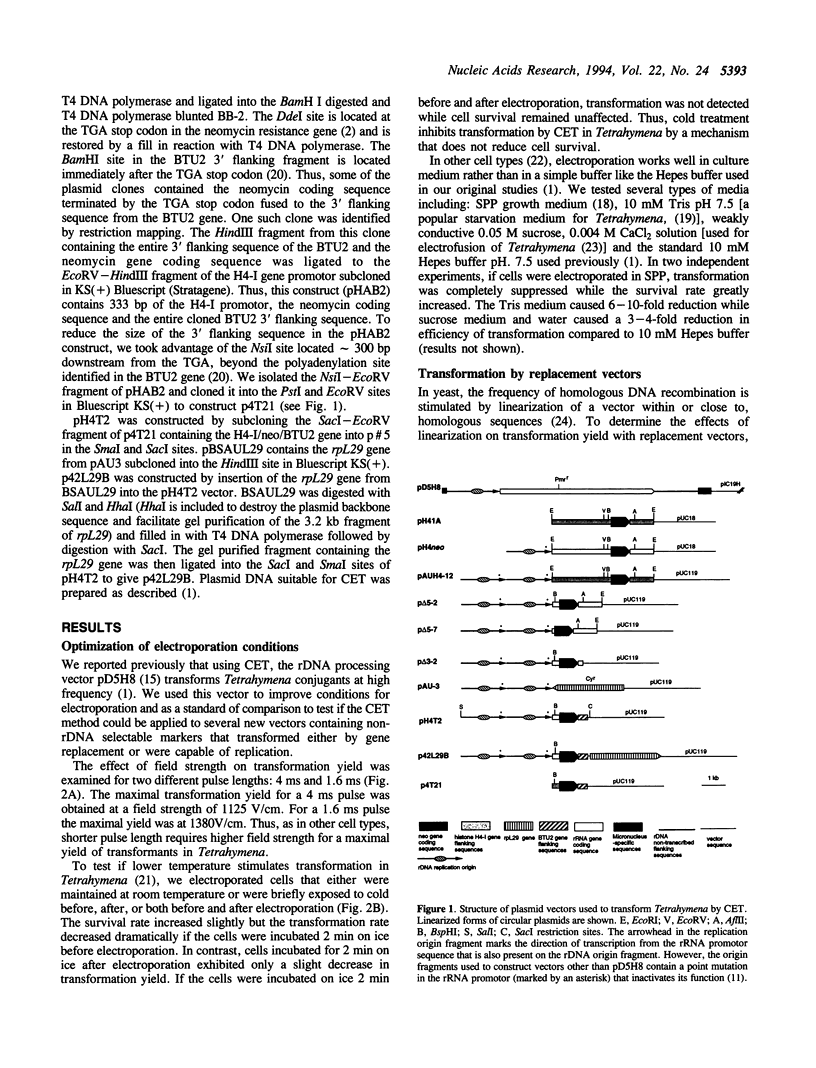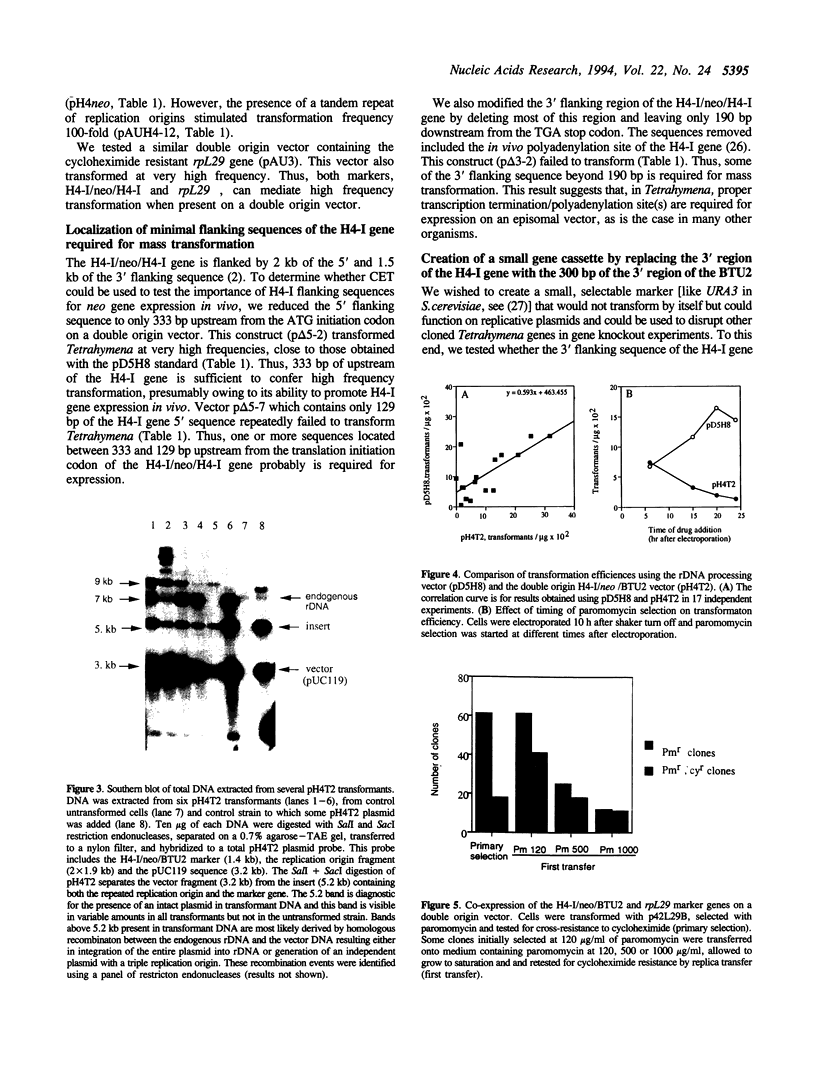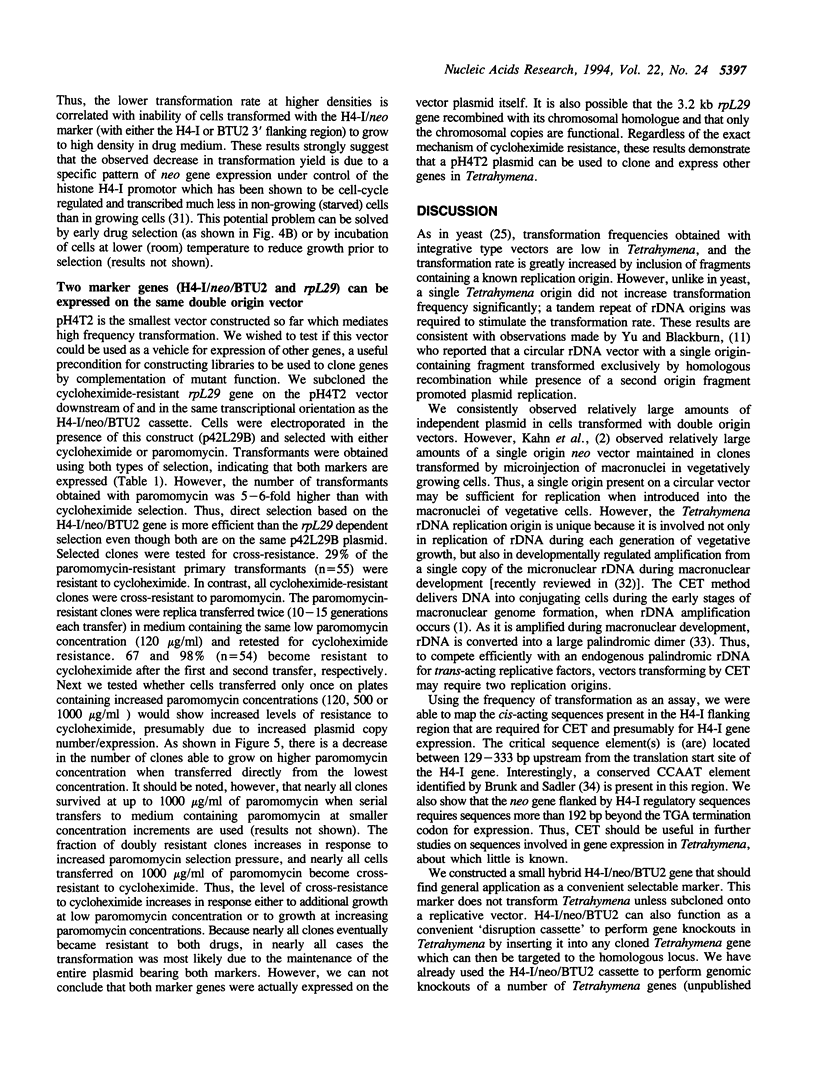Abstract
Recently, we developed a mass DNA-mediated transformation technique for the ciliated protozoan Tetrahymena thermophila that introduces transforming DNA by electroporation into conjugating cells. Other studies demonstrated that a neomycin resistance gene flanked by Tetrahymena H4-I gene regulatory sequences transformed Tetrahymena by homologous recombination within the H4-I locus when microinjected into the macronucleus. We describe the use of conjugant electrotransformation (CET) for gene replacement and for the development of new independently replicating vectors and a gene cassette that can be used as a selectable marker in gene knockout experiments. Using CET, the neomycin resistance gene flanked by H4-I sequences transformed Tetrahymena, resulting in the replacement of the H4-I gene or integrative recombination of the H4-I/neo/H4-I gene (but not vector sequences) in the 5' or 3' flanking region of the H4-I locus. Gene replacement was obtained with non-digested plasmid DNA but releasing the insert increased the frequency of replacement events about 6-fold. The efficiency of transformation by the H4-I/neo/H4-I selectable marker was unchanged when a single copy of the Tetrahymena rDNA replication origin was included on the transforming plasmid. However, the efficiency of transformation using CET increased greatly when a tandem repeat of the replication origin fragment was used. This high frequency of transformation enabled mapping of the region required for H4-I promoter function to within 333 bp upstream of the initiator ATG. Similarly approximately 300 bp of sequence downstream of the translation terminator TGA of the beta-tubulin 2 (BTU2) gene could substitute for the 3' region of the H4-I gene. This hybrid H4-I/neo/BTU2 gene did not transform Tetrahymena when subcloned on a plasmid lacking an origin of replication, but did transform at high frequency on a two origin plasmid. Thus, the H4-I/neo/BTU2 cassette is a selectable marker that can be used for gene knockout in Tetrahymena. As a first step toward constructing a vector suitable for cloning genes by complementation of mutations in Tetrahymena, we also demonstrated that the vector containing 2 origins and the H4-I/neo/BTU2 cassette can co-express a gene encoding a cycloheximide resistant ribosomal protein.
Full text
PDF







Images in this article
Selected References
These references are in PubMed. This may not be the complete list of references from this article.
- Alani E., Cao L., Kleckner N. A method for gene disruption that allows repeated use of URA3 selection in the construction of multiply disrupted yeast strains. Genetics. 1987 Aug;116(4):541–545. doi: 10.1534/genetics.112.541.test. [DOI] [PMC free article] [PubMed] [Google Scholar]
- Blackburn E. H. Telomeres. Trends Biochem Sci. 1991 Oct;16(10):378–381. doi: 10.1016/0968-0004(91)90155-o. [DOI] [PubMed] [Google Scholar]
- Brunk C. F., Sadler L. A. Characterization of the promoter region of Tetrahymena genes. Nucleic Acids Res. 1990 Jan 25;18(2):323–329. doi: 10.1093/nar/18.2.323. [DOI] [PMC free article] [PubMed] [Google Scholar]
- Chu G., Hayakawa H., Berg P. Electroporation for the efficient transfection of mammalian cells with DNA. Nucleic Acids Res. 1987 Feb 11;15(3):1311–1326. doi: 10.1093/nar/15.3.1311. [DOI] [PMC free article] [PubMed] [Google Scholar]
- Gaertig J., Gorovsky M. A. Efficient mass transformation of Tetrahymena thermophila by electroporation of conjugants. Proc Natl Acad Sci U S A. 1992 Oct 1;89(19):9196–9200. doi: 10.1073/pnas.89.19.9196. [DOI] [PMC free article] [PubMed] [Google Scholar]
- Gaertig J., Kiersnowska M., Iftode F. Induction of cybrid strains of Tetrahymena thermophila by electrofusion. J Cell Sci. 1988 Feb;89(Pt 2):253–261. doi: 10.1242/jcs.89.2.253. [DOI] [PubMed] [Google Scholar]
- Gaertig J., Thatcher T. H., Gu L., Gorovsky M. A. Electroporation-mediated replacement of a positively and negatively selectable beta-tubulin gene in Tetrahymena thermophila. Proc Natl Acad Sci U S A. 1994 May 10;91(10):4549–4553. doi: 10.1073/pnas.91.10.4549. [DOI] [PMC free article] [PubMed] [Google Scholar]
- Gaertig J., Thatcher T. H., McGrath K. E., Callahan R. C., Gorovsky M. A. Perspectives on tubulin isotype function and evolution based on the observation that Tetrahymena thermophila microtubules contain a single alpha- and beta-tubulin. Cell Motil Cytoskeleton. 1993;25(3):243–253. doi: 10.1002/cm.970250305. [DOI] [PubMed] [Google Scholar]
- Godiska R., Yao M. C. A programmed site-specific DNA rearrangement in Tetrahymena thermophila requires flanking polypurine tracts. Cell. 1990 Jun 29;61(7):1237–1246. doi: 10.1016/0092-8674(90)90688-b. [DOI] [PubMed] [Google Scholar]
- Gorovsky M. A., Yao M. C., Keevert J. B., Pleger G. L. Isolation of micro- and macronuclei of Tetrahymena pyriformis. Methods Cell Biol. 1975;9(0):311–327. doi: 10.1016/s0091-679x(08)60080-1. [DOI] [PubMed] [Google Scholar]
- Greider C. W., Blackburn E. H. A telomeric sequence in the RNA of Tetrahymena telomerase required for telomere repeat synthesis. Nature. 1989 Jan 26;337(6205):331–337. doi: 10.1038/337331a0. [DOI] [PubMed] [Google Scholar]
- Horowitz S., Bowen J. K., Bannon G. A., Gorovsky M. A. Unusual features of transcribed and translated regions of the histone H4 gene family of Tetrahymena thermophila. Nucleic Acids Res. 1987 Jan 12;15(1):141–160. doi: 10.1093/nar/15.1.141. [DOI] [PMC free article] [PubMed] [Google Scholar]
- Johnson K. A. Preparation and properties of dynein from Tetrahymena cilia. Methods Enzymol. 1986;134:306–317. doi: 10.1016/0076-6879(86)34098-9. [DOI] [PubMed] [Google Scholar]
- Kahn R. W., Andersen B. H., Brunk C. F. Transformation of Tetrahymena thermophila by microinjection of a foreign gene. Proc Natl Acad Sci U S A. 1993 Oct 15;90(20):9295–9299. doi: 10.1073/pnas.90.20.9295. [DOI] [PMC free article] [PubMed] [Google Scholar]
- Kapler G. M. Developmentally regulated processing and replication of the Tetrahymena rDNA minichromosome. Curr Opin Genet Dev. 1993 Oct;3(5):730–735. doi: 10.1016/s0959-437x(05)80091-7. [DOI] [PubMed] [Google Scholar]
- Orr-Weaver T. L., Szostak J. W., Rothstein R. J. Yeast transformation: a model system for the study of recombination. Proc Natl Acad Sci U S A. 1981 Oct;78(10):6354–6358. doi: 10.1073/pnas.78.10.6354. [DOI] [PMC free article] [PubMed] [Google Scholar]
- Potter H., Weir L., Leder P. Enhancer-dependent expression of human kappa immunoglobulin genes introduced into mouse pre-B lymphocytes by electroporation. Proc Natl Acad Sci U S A. 1984 Nov;81(22):7161–7165. doi: 10.1073/pnas.81.22.7161. [DOI] [PMC free article] [PubMed] [Google Scholar]
- Struhl K., Stinchcomb D. T., Scherer S., Davis R. W. High-frequency transformation of yeast: autonomous replication of hybrid DNA molecules. Proc Natl Acad Sci U S A. 1979 Mar;76(3):1035–1039. doi: 10.1073/pnas.76.3.1035. [DOI] [PMC free article] [PubMed] [Google Scholar]
- Tondravi M. M., Yao M. C. Transformation of Tetrahymena thermophila by microinjection of ribosomal RNA genes. Proc Natl Acad Sci U S A. 1986 Jun;83(12):4369–4373. doi: 10.1073/pnas.83.12.4369. [DOI] [PMC free article] [PubMed] [Google Scholar]
- Weindruch R. H., Doerder F. P. Age-dependent micronuclear deterioration in Tetrahymena pyriformis, syngen 1. Mech Ageing Dev. 1975 May-Aug;4(3-4):263–279. doi: 10.1016/0047-6374(75)90028-7. [DOI] [PubMed] [Google Scholar]
- Yao M. C., Yao C. H. Accurate processing and amplification of cloned germ line copies of ribosomal DNA injected into developing nuclei of Tetrahymena thermophila. Mol Cell Biol. 1989 Mar;9(3):1092–1099. doi: 10.1128/mcb.9.3.1092. [DOI] [PMC free article] [PubMed] [Google Scholar]
- Yao M. C., Yao C. H., Monks B. The controlling sequence for site-specific chromosome breakage in Tetrahymena. Cell. 1990 Nov 16;63(4):763–772. doi: 10.1016/0092-8674(90)90142-2. [DOI] [PubMed] [Google Scholar]
- Yao M. C., Yao C. H. Transformation of Tetrahymena to cycloheximide resistance with a ribosomal protein gene through sequence replacement. Proc Natl Acad Sci U S A. 1991 Nov 1;88(21):9493–9497. doi: 10.1073/pnas.88.21.9493. [DOI] [PMC free article] [PubMed] [Google Scholar]
- Yasuda L. F., Yao M. C. Short inverted repeats at a free end signal large palindromic DNA formation in Tetrahymena. Cell. 1991 Nov 1;67(3):505–516. doi: 10.1016/0092-8674(91)90525-4. [DOI] [PubMed] [Google Scholar]
- Yu G. L., Blackburn E. H. Amplification of tandemly repeated origin control sequences confers a replication advantage on rDNA replicons in Tetrahymena thermophila. Mol Cell Biol. 1990 May;10(5):2070–2080. doi: 10.1128/mcb.10.5.2070. [DOI] [PMC free article] [PubMed] [Google Scholar]
- Yu G. L., Blackburn E. H. Developmentally programmed healing of chromosomes by telomerase in Tetrahymena. Cell. 1991 Nov 15;67(4):823–832. doi: 10.1016/0092-8674(91)90077-c. [DOI] [PubMed] [Google Scholar]
- Yu G. L., Blackburn E. H. Transformation of Tetrahymena thermophila with a mutated circular ribosomal DNA plasmid vector. Proc Natl Acad Sci U S A. 1989 Nov;86(21):8487–8491. doi: 10.1073/pnas.86.21.8487. [DOI] [PMC free article] [PubMed] [Google Scholar]
- Yu G. L., Bradley J. D., Attardi L. D., Blackburn E. H. In vivo alteration of telomere sequences and senescence caused by mutated Tetrahymena telomerase RNAs. Nature. 1990 Mar 8;344(6262):126–132. doi: 10.1038/344126a0. [DOI] [PubMed] [Google Scholar]
- Yu G. L., Hasson M., Blackburn E. H. Circular ribosomal DNA plasmids transform Tetrahymena thermophila by homologous recombination with endogenous macronuclear ribosomal DNA. Proc Natl Acad Sci U S A. 1988 Jul;85(14):5151–5155. doi: 10.1073/pnas.85.14.5151. [DOI] [PMC free article] [PubMed] [Google Scholar]



